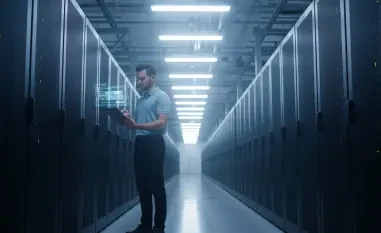The integration of artificial intelligence (AI) into cybersecurity strategies has become indispensable as cyber threats grow more sophisticated. Traditional defense mechanisms, which relied heavily on human vigilance, manual monitoring, static firewalls, and reactionary responses, are no longer sufficient. The rapid technological evolution demands smarter, faster, and more adaptable solutions. AI’s ability to process vast amounts of data in real-time allows it to predict and prevent threats rather than merely react to them. AI systems can identify anomalies and risks by automating threat detection that would often go unnoticed in complex network environments. For example, AI can detect subtle patterns in network traffic that signal potential breaches before they escalate. This proactive approach is crucial in managing ransomware attacks, phishing schemes, and other cyber threats.
The Role of AI in Enhancing Cybersecurity
Proactive Threat Detection
One of AI’s most compelling capabilities within cybersecurity is its capacity to analyze massive datasets in real-time, which enables it to identify potential threats before they become significant. Traditional security methods often rely on known threat signatures, but AI can detect new, unknown threats by recognizing patterns and anomalies in the data. This proactive detection is essential in preventing attacks such as ransomware and phishing schemes, which can cause substantial damage if not caught early. AI’s sophisticated algorithms continually learn from a variety of datasets, making them highly effective at predicting future threat vectors and reducing false positives that typically plague traditional systems.
The advantage of AI’s real-time analysis is particularly notable in environments where the volume and complexity of data make manual monitoring impractical. By leveraging machine learning models, AI can discern malicious activity from normal behavior, flagging threats that might go undetected by human eyes. This enables organizations to respond promptly to potential security breaches, ultimately safeguarding sensitive information and mitigating risks. As cyber attackers employ increasingly complex tactics, AI’s proactive detection capabilities become a critical component of a robust cybersecurity strategy, helping businesses stay one step ahead.
Automating Threat Response
AI’s contribution to cybersecurity extends beyond merely detecting threats; it also automates responses to mitigate them effectively. Automation drastically reduces the time between threat detection and response, minimizing potential damage. For instance, AI systems can automatically isolate affected systems, block malicious IP addresses, and alert security teams to take further action. This rapid response capability is crucial in today’s fast-paced cyber threat landscape, where even a few minutes can make a significant difference in preventing data loss or system compromise.
Automating threat response streamlines the decision-making process, freeing up human experts to focus on more strategic tasks. AI-driven automation ensures consistent and precise actions, reducing the likelihood of human error. Furthermore, the implementation of self-healing networks, where AI systems can autonomously identify and rectify vulnerabilities, marks a significant leap forward in cybersecurity. This shift towards autonomous threat management allows organizations to maintain robust security postures even when facing resource constraints, such as limited cybersecurity personnel or budgetary limitations. The integration of AI in automating threat response reflects a broader trend towards efficiency and effectiveness, enhancing the overall resilience of cybersecurity defenses.
Adaptability of AI Systems
AI systems have consistently demonstrated their capability to adapt to various tasks and environments. This adaptability is largely due to machine learning algorithms, which enable systems to learn from data and improve over time. By analyzing vast amounts of information, AI can identify patterns and trends that would be difficult for humans to detect. As a result, these systems are increasingly being utilized in fields such as healthcare, finance, and transportation, where they can provide valuable insights and optimize processes. With ongoing advancements in AI technology, the potential for these systems to revolutionize industries continues to grow.
Continuous Learning and Evolution
One of AI’s most transformative attributes is its adaptability. Unlike traditional systems that fail if parameters are not explicitly defined, AI evolves with the changing threat landscape. Machine learning models continually adapt to new threats, ensuring defenses remain a step ahead of attackers. Advanced AI capabilities, such as natural language processing (NLP), enable these systems to understand and interpret adversarial prompts better than static algorithms. This ability to learn from new data in real-time enables AI systems to evolve autonomously, providing an ever-improving defense mechanism against emerging threats.
The continuous learning aspect of AI is pivotal in maintaining effective cybersecurity measures. As attackers develop more sophisticated methods, AI’s adaptive learning ensures that it is not just reactive but anticipatory in its approach. Through techniques such as supervised learning and unsupervised learning, AI systems can digest vast amounts of data from diverse sources, identifying novel threats and adjusting defensive strategies accordingly. This dynamic nature makes AI an invaluable tool in cybersecurity, allowing organizations to remain resilient against an ever-evolving landscape of cyber threats.
Red Teaming and Vulnerability Assessment
Ensuring the safety and reliability of AI systems requires rigorous testing to identify and address weaknesses. Red teaming, a strategic probing technique, reveals how AI systems interact with the real world and uncovers potential flaws that could lead to catastrophic consequences if unchecked. Understanding an AI system’s application and potential failure points is the first step in comprehensive vulnerability assessment. Red teaming involves a group of experts simulating attacks to test the system’s defenses, highlighting areas that need improvement and ensuring the system’s robustness under various attack scenarios.
Red teaming goes beyond traditional vulnerability assessments by incorporating threat intelligence and understanding attackers’ mindset. This proactive approach ensures that AI systems are not only tested for known vulnerabilities but also for potential unknown attack vectors. By employing sophisticated simulation techniques, security teams can gain insights into how AI systems might behave under real-world conditions, making necessary adjustments to improve resilience. The iterative process of red teaming and subsequent vulnerability mitigation is a critical component of maintaining secure AI systems, ensuring they can withstand complex cyber threats over time.
AI Vulnerabilities and Adversarial Inputs
Artificial Intelligence systems are susceptible to various types of vulnerabilities, particularly adversarial inputs designed to exploit weaknesses. Adversarial inputs can be subtly altered data fed into AI models to cause errors or unintended behavior. This poses significant challenges to the reliability and security of AI applications, from image recognition to natural language processing. Ensuring robust defenses against such adversarial attacks is crucial for the safe deployment of AI technologies in critical areas. Advances in AI security aim to detect and mitigate these risks, fortifying AI systems against potential exploits and ensuring their trustworthy operation in real-world scenarios.
undefined
Not all AI vulnerabilities require sophisticated attacks. Simple, well-crafted adversarial inputs can bypass even the most advanced safety measures. A classic example is phishing attempts exploiting AI’s instruction-following capability to subtly nudge the system towards harmful behavior. This accessibility highlights the necessity to address risks at all system levels—from core design to real-world usage. Understanding that vulnerabilities can arise from seemingly innocuous interactions underscores the importance of comprehensive security measures that encompass the entire lifecycle of AI systems.
The simplicity of certain attacks does not diminish their potential impact. For instance, a well-timed phishing email may exploit an AI system’s pattern recognition abilities, prompting it to approve unauthorized access or execute malicious code. Adversarial inputs, even those that appear benign, can be meticulously designed to exploit specific weaknesses in AI algorithms. This necessitates a multi-layered defense strategy, incorporating robust input validation, continuous monitoring, and regular updates to safeguard against a wide array of adversarial tactics. Ensuring that AI systems can differentiate between legitimate queries and potentially harmful inputs is crucial in maintaining their integrity and reliability.
Automation in Testing
Automation in testing broadens the scope of risk analysis, uncovering a wider array of vulnerabilities across diverse use cases and contexts. Whether simulating phishing schemes, exploring edge-case inputs, or identifying data leakage points, automated testing ensures comprehensive vulnerability discovery. This approach ensures that AI systems are robust and resilient against a variety of potential threats. Automated tools can systematically and repeatedly test AI systems under various conditions, providing consistent and thorough assessments that might be beyond the capabilities of manual testing.
Utilizing automation in testing leverages the strengths of AI itself, allowing for continuous improvement and adaptation. Automated testing frameworks can simulate complex attack scenarios at scale, providing valuable insights into potential weaknesses that might be exploited by malicious actors. This ensures that any discovered vulnerabilities are promptly addressed, reinforcing the overall security posture of AI systems. The efficiency and comprehensiveness of automated testing make it an essential practice in the maintenance and enhancement of AI-driven cybersecurity measures, ultimately contributing to a more secure digital environment.
The Human Element in AI Security
Adversarial Thinking and Creativity
Despite the power of automation, human creativity remains indispensable. Red teaming requires adversarial thinking, which often necessitates a nuanced understanding of culture, context, and intent. Certain vulnerabilities, such as a system’s response to emotionally charged prompts, are best identified by experienced testers who can evaluate ethical and social implications. This human judgment ensures that red teaming goes beyond technical assessment, exploring how systems might behave in complex real-world scenarios. While automation handles the repetitive aspects of vulnerability testing, the human element provides the critical analytical and strategic insights needed to address sophisticated and context-specific threats.
The human element in AI security plays a vital role in interpreting results and making informed decisions. It takes human experience and creativity to envision the multifaceted ways adversaries might exploit vulnerabilities. Analysts can assess not only the technical flaws but also the broader implications of security breaches, including potential impacts on privacy, public trust, and regulatory compliance. This comprehensive perspective is essential for developing robust security strategies that account for the full spectrum of risks associated with AI systems. Human expertise ensures that AI security measures are not just reactive but preemptively designed to mitigate potential threats.
Ethical and Social Implications
Human experts play a crucial role in evaluating the ethical and social implications of AI systems. They ensure that AI behaves responsibly and does not perpetuate biases or harmful assumptions. This ethical oversight is essential in building trust and accountability into AI security, ensuring that AI systems are not only technically robust but also socially responsible. Understanding the potential societal impact of AI decisions and outputs requires a human touch, as automated systems might lack the context to fully grasp the ramifications of their actions.
Addressing the ethical and social implications of AI extends to ensuring that these systems operate with transparency and fairness. This involves regular audits and assessments to prevent and mitigate biases that could arise from skewed training data or flawed algorithms. Human oversight helps ensure that AI technologies contribute positively to society, avoiding discrimination and other adverse effects. Moreover, fostering ethical AI use builds public trust, which is vital for widespread adoption and reliance on AI in critical sectors. By embedding ethical considerations into AI security practices, organizations can create AI systems that are not only effective but also aligned with broader social values.
Transitioning from Banking to Cybersecurity
Transitioning from a career in banking to one in cybersecurity can be a challenging yet rewarding move. The skills acquired in banking, such as attention to detail, risk management, and regulatory compliance, can be highly transferable to the field of cybersecurity. As cyber threats become more sophisticated, there is a growing need for professionals who can protect sensitive financial information and ensure the security of banking systems. This shift not only opens up new career opportunities but also allows individuals to contribute to a critical aspect of the modern digital economy.
Lessons from Financial Fraud Detection
Banks have long used pattern recognition to detect anomalies, whether in transaction activity or counterfeit documents. These principles, amplified by AI, now enhance cybersecurity. Adaptive algorithms analyze behavior and patterns in real-time to identify potential threats, making defenses faster and more precise. This experience from banking translates directly to cybersecurity, where data protection remains a cornerstone of strategy. AI-driven pattern recognition enables early detection of unauthorized activities, securing digital assets against sophisticated cyber threats.
Financial institutions have leveraged AI technologies to prevent fraud by identifying unusual transaction patterns and customer behaviors. These methodologies are directly applicable to cybersecurity, where similar techniques can detect anomalies in network traffic or user activities. The banking sector’s stringent regulatory environment has also fostered a culture of thorough risk assessment and mitigation, providing valuable insights for cybersecurity practices. Financial fraud detection’s emphasis on real-time data analysis and immediate response parallels the needs of cybersecurity, underscoring the transferability of expertise between these fields.
Unique Challenges in Cybersecurity
Cybersecurity presents unique challenges due to the constantly evolving nature of threats, the increasing sophistication of cyber attacks, and the need to protect vast amounts of sensitive data. As technology advances, so do the methods employed by cyber criminals, making it crucial for organizations to stay ahead with robust security measures. Additionally, the widespread use of remote work and interconnected devices has expanded the attack surface, requiring a comprehensive approach to safeguarding digital assets.
While banking taught vigilance, cybersecurity introduces unique challenges, particularly with AI systems. For example, data exfiltration can occur silently in AI-reliant systems, and system-level vulnerabilities, such as insecure APIs, create new attack surfaces. A notable case involves using large language models (LLMs) to automate scams, exploiting human trust on a psychological level. These challenges necessitate advanced AI solutions that can identify and address sophisticated threats effectively.
Cybersecurity’s dynamic landscape requires continuous adaptation and innovation. Unlike banking, where fraud patterns might be relatively stable, cybersecurity threats evolve rapidly, demanding agile and responsive defense mechanisms. The integration of AI in cybersecurity allows for adaptive responses to emerging threats, leveraging machine learning for continuous improvement. However, this also means that cybersecurity professionals must stay abreast of the latest advancements and potential vulnerabilities in AI technologies. The unique challenges of cybersecurity, combined with AI’s evolving role, require a comprehensive approach that includes ongoing education, collaboration, and investment in cutting-edge technologies.
AI’s Role in Next-Gen Security Strategies
Dynamic and Adaptive Defenses
Cybersecurity’s fundamental nature has always been to stay ahead of attackers, but AI has changed the engagement rules. Static defenses are insufficient in today’s threat environment, necessitating adaptive, AI-powered systems that evolve with emerging threats. Static security methods relied on predefined rules, detecting and acting upon known malicious signatures. However, today’s threats evolve too quickly for this reactive approach. AI offers a dynamic alternative with adaptive models that continuously learn from data, identifying real-time patterns that humans might miss. This shift ensures defenses remain effective as attack methods evolve.
AI’s ability to develop dynamic defenses hinges on continuous learning and adaptation. By analyzing vast amounts of data from various sources, AI systems can identify emerging threat vectors and adjust defense mechanisms accordingly. The shift from static to dynamic defenses marks a significant evolution in cybersecurity, as AI-powered systems can anticipate and mitigate threats before they fully materialize. This proactive stance not only enhances security but also minimizes response time, reducing the potential impact of cyberattacks. AI’s adaptive capabilities serve as a critical component in the development of next-generation security strategies, providing a robust and resilient defense framework.
The Impact of Generative AI
Generative AI brings both potential and peril to cybersecurity. On one hand, it powers advanced tools that simulate and anticipate attacks, providing invaluable insights. On the other, it introduces novel harm categories, such as misinformation campaigns and the adversarial misuse of AI tools. These risks require redefining security to protect not just data but the trust underpinning digital ecosystems. Ensuring that generative AI is used responsibly involves balancing innovation with the need for stringent security measures, mitigating the risks associated with its misuse.
Generative AI’s ability to create realistic content, whether it be text, images, or audio, poses unique challenges for cybersecurity. Adversaries can exploit this technology to generate convincing phishing emails, deepfake videos, and fake news, undermining trust and causing significant harm. Addressing these threats necessitates advanced AI-driven detection tools capable of identifying and countering generative AI’s malicious uses. Additionally, the ethical implications of generative AI must be carefully managed, ensuring that its deployment aligns with societal values and legal standards. By leveraging generative AI for defensive purposes while mitigating its potential for harm, cybersecurity professionals can harness its capabilities to enhance security resilience.
Leveraging Automation for AI-Driven Testing
Scaling Security with Automation
Scaling modern cybersecurity strategies is impossible without automation. Open-source frameworks have become invaluable for red-teaming operations, automating AI system testing at unprecedented scales. These frameworks enable security teams to simulate diverse attack scenarios efficiently. Automation amplifies human ingenuity by handling repetitive tasks, freeing experts to focus on complex problem-solving. This combination ensures resilience and precision in cybersecurity efforts, streamlining the identification and mitigation of vulnerabilities.
The use of automation in AI-driven testing transforms the approach to cybersecurity, enabling extensive and thorough evaluations that might otherwise be unfeasible. Automated tools can conduct continuous monitoring and testing, providing real-time feedback on system vulnerabilities and performance. This proactive approach allows for rapid detection and response to potential threats, enhancing the overall security posture. By integrating automation with human expertise, cybersecurity teams can maintain a vigilant and adaptive defense strategy, ensuring ongoing protection against evolving cyber threats.
Comprehensive Vulnerability Discovery
Automation in testing broadens the scope of risk analysis, uncovering a wider array of vulnerabilities across diverse use cases and contexts. Whether simulating phishing schemes, exploring edge-case inputs, or identifying data leakage points, automated testing ensures comprehensive vulnerability discovery. This approach ensures that AI systems are robust and resilient against a variety of potential threats. By leveraging automated frameworks, security teams can systematically assess AI systems’ security, ensuring thorough and consistent evaluations.
Comprehensive vulnerability discovery through automation enables cybersecurity professionals to address both known and unknown threats effectively. Automated testing tools can explore complex scenarios and edge cases that might be overlooked during manual testing. This thorough examination helps identify subtle vulnerabilities that could be exploited by sophisticated attackers. The integration of automated testing with continuous learning ensures that AI systems remain resilient and adaptive, providing robust protection against an increasingly dynamic threat landscape. By prioritizing comprehensive vulnerability discovery, organizations can enhance their defense mechanisms and maintain a secure digital environment.
Future-Proofing AI Security
With the rapid advancement of artificial intelligence technologies, ensuring robust AI security measures has become paramount. Future-proofing AI security involves creating systems that can anticipate and mitigate potential threats before they become critical issues. This means incorporating advanced encryption, developing algorithms that can detect and adapt to new types of attacks, and continuously updating security protocols to address evolving risks. Additionally, fostering collaboration between AI researchers, cybersecurity experts, and policymakers is essential to create a unified approach to safeguarding AI technologies. By taking these proactive steps, we can protect AI systems from vulnerabilities and ensure their safe and ethical use in the future.
Continuous Testing and Evolution
Continuous testing and evolution are crucial for ensuring the success and reliability of any system. By constantly testing and refining processes, businesses can adapt to changing environments and maintain a competitive edge. This approach helps identify potential issues early, reducing the risk of failure and improving overall performance. Moreover, continuous evolution fosters innovation, enabling organizations to stay ahead of industry trends and meet the ever-evolving needs of their customers.
Future-proofing cybersecurity involves building resilient, adaptive systems through continuous testing and evolution. The break-fix cycle—a process of repeatedly testing, identifying, and fixing vulnerabilities—is critical. Red teaming plays a crucial role in this iterative approach, ensuring defenses anticipate and counter threats effectively. Balancing innovation with regulation is essential. Over-regulation can stifle progress, while insufficient oversight can lead to chaos. Cybersecurity strategies must strike a balance, advancing technology while adhering to safety frameworks.
Continuous testing and evolution are essential for maintaining robust cybersecurity defenses. By regularly assessing and updating AI systems, organizations can adapt to new threats and vulnerabilities. This proactive approach ensures that security measures remain effective over time, accommodating the dynamic nature of cyber threats. The balance between innovation and regulation is critical for fostering technological advancement without compromising security. Cybersecurity professionals must navigate this delicate balance, ensuring that AI systems are both innovative and secure, paving the way for a resilient digital future.
Cross-Industry Collaboration
Collaboration, a valuable lesson from banking, enhances cybersecurity. Financial institutions provide a blueprint for trust, accountability, and risk management. Similarly, cybersecurity can benefit from collective efforts and diverse perspectives across industries, geographies, and cultures. Collaborative initiatives can drive innovation, share best practices, and promote a unified approach to addressing cybersecurity challenges. By leveraging cross-industry insights and experiences, cybersecurity professionals can develop more comprehensive and effective defense strategies.
Cross-industry collaboration fosters a holistic approach to cybersecurity, encouraging knowledge sharing and resource pooling. Collaborative efforts can facilitate the development of standardized security practices, enhancing overall resilience against cyber threats. By engaging with diverse stakeholders, cybersecurity professionals can gain unique insights and perspectives, enriching their understanding of potential vulnerabilities and solutions. This collective effort strengthens the global cybersecurity landscape, promoting a secure digital environment for all. Embracing cross-industry collaboration is essential for addressing the complex and evolving challenges of cybersecurity, ensuring a robust and resilient defense framework.
Conclusion: Proactivity and Ethical Security
To safeguard the future, industries must embrace AI-driven cybersecurity strategies. Waiting for threats to materialize is no longer viable—proactivity has become imperative. Continuous testing, balanced innovation, cross-industry knowledge, and ethical alignment are the pillars for building secure and sustainable AI systems.
Adopting continuous testing ensured that defenses evolved with emerging threats. Balancing innovation with regulation fostered technological advancements without compromising safety. Leveraging cross-industry insights enriched cybersecurity strategies. Automation enhanced scalability while human experts addressed complex risks and ethical implications. Prioritizing ethical alignment built trust and accountability into AI security.
In essence, the integration of AI in cybersecurity was not just about technological robustness but about fostering trust and ethical principles. Through proactive measures and collective efforts, the future of digital security became resilient and adaptive.













